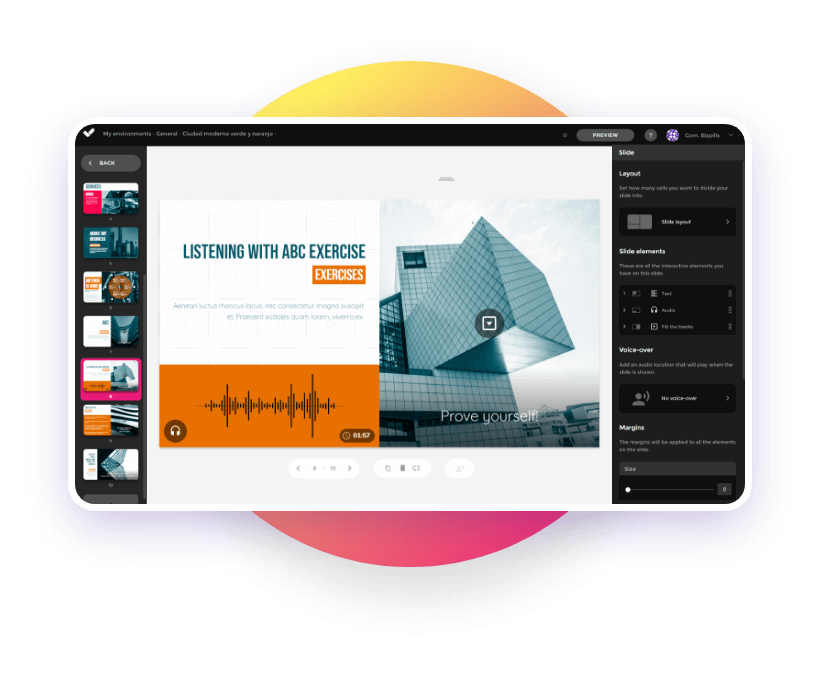Table of contents
ToggleImagine yourself in the following scenario: you are leading a training session on sales technique for a sizable team. During the session, the employees begin to collaborate actively, eagerly sharing personal insights and valuable information on how to approach sales more effectively. This moment is an example of the value of knowledge sharing, a powerful exchange of knowledge that can occur at all levels of an organization.
In the business world, this act of sharing knowledge is essential, as it allows each employee to learn and improve from the experience gained by their colleagues. However, in order for these actions to have a real impact on growth and development within a company, it is not enough for workers to simply receive advice from others. Instead, the process must be carried out with a firm strategy, clear communication, and the correct tools. Together, these measures will foster an effective culture of knowledge sharing. In this post, we’ll explain exactly how to achieve this.
What is a culture of knowledge sharing?
Knowledge, in a general context, is a set of information, skills and experiences accumulated over time, and typically acquired through observation, direct experience or education, both formal and informal. In a business setting, it becomes a powerful tool that guides our progress and allows us to understand, innovate and grow. This is what makes a culture of knowledge sharing far more than a simple learning strategy, requiring you to foster an environment where the free exchange of ideas, experiences and skills is actively encouraged.
Within this type of culture, knowledge comes to be perceived as a collective asset that enriches the whole organization, rather than an individual possession. This awareness promotes collaboration, transparency and openness, generating a consistent flow of information that nourishes decision-making and innovation alike.
The benefits of establishing a culture of knowledge sharing in your company
Knowledge exchange is the cornerstone of building a strong culture of shared knowledge. Through this practice, collaboration and teamwork are both dramatically improved. Sharing information and experience on company processes, preferences and strategies also helps to raise the performance level of the entire organization, avoiding the unnecessary duplication of efforts and maximizing efficiency.
In work environments where knowledge is shared, employees feel empowered. Because they have consistent access to the information they need, they can make quick and informed decisions, helping to spark creativity and innovation.
But that’s not all – a culture of knowledge sharing also helps to improve the work environment. Employees start to feel more comfortable and open to participating in shared projects, thereby strengthening their sense of belonging and commitment to common goals.
Common obstacles when building a culture of knowledge sharing, and how to overcome them
Building a culture of knowledge sharing is an ongoing process – not only requiring you to consistently collect data, but also to foster a working environment where the free exchange of ideas, experiences and skills becomes the norm. However, in order to take these steps, it is first necessary to identify any individual or team behaviors that may be preventing you from progressing towards your goal, and determine how to change them:
- Over-dependence on specific employees: when your team cannot complete a particular task or project because one of its members is absent, it implies a low level of general autonomy, and over-reliance on that one team member. In teams which enjoy a balanced culture of knowledge sharing, all members should bear a greater sense of individual responsibility, as well as an awareness of shared authority. This will help them to drive efficiency and operational flexibility. Each member must have both the ability and confidence to carry out tasks and projects individually, even in the absence of others.
- Unfair competition: when one or more of your company’s employees withholds strategic information, looking to gain a personal advantage over their colleagues instead of sharing it for the benefit of the whole team. Within a culture of knowledge sharing, all members work together towards common goals, building balanced, reliable teams instead of seeking individual advantages.
- Departmental silos: when individual departments or teams operate in isolation and jealously guard their knowledge, instead of sharing resources with other parts of the company. By encouraging the open exchange of knowledge and resources between different areas of the company, better synergy and integration can be achieved. All team members can then leverage the strengths and experiences of other departments to maximize operational efficiency at all levels of the organization.
- Duplicated efforts: when different teams or departments are working on similar projects, and end up repeating efforts due to poor communication. This inevitably results in a waste of both time and resources. By facilitating open, transparent communication, the duplication of efforts can be minimized and available resources optimized, so teams can coordinate more efficiently to meet objectives.
- A culture of secrecy: when information is kept under lock and key within a company, and passed only between a privileged few, instead of being shared openly and transparently at all levels. On the other hand, in a culture of knowledge sharing, trust and transparency can be built up effectively. An environment where information is shared freely at all organizational levels helps to foster a sense of belonging and commitment, and this in turn creates a positive and motivating atmosphere.
How to build a culture of knowledge sharing in your company
Now that we know which behaviors can limit us when attempting to establish a culture of knowledge sharing, it’s time to implement a strategy that allows us to enjoy all the advantages of a more open approach to knowledge and information. The following steps should help you to do this:
Step 1: Establish the value of knowledge
Before implementing any change in your organization, it’s important to first communicate your wider vision, or reason for change, to all team members. In this case, employees need to understand why sharing knowledge is so important, while leaders, whose role is to set an example to those employees, should not only understand its importance but also promote it.
Step 2: Assess current needs and tools
At this point, you’ll need to carry out a knowledge inventory – this consists of identifying which knowledge is essential among your employees, as well as who possesses it and what, if anything, is missing. Once you know this, you can plan a training strategy using tools that facilitate the free exchange of information.
Step 3: Choose tools and technologies that make collaboration and knowledge sharing easy
Not all organizations have spaces where employees can meet and share ideas. Luckily, there are technological tools available that allow you to share and access information whenever necessary. Let’s take a closer look at them below:
Authoring tools
When attempting to develop a culture of knowledge sharing in your organization, you should keep in mind that those who possess important skills and knowledge need an agile and simple way of sharing them with others. An authoring tool is perfect for this, as it allows users to create interactive, attractive training content without the need for prior design or programming skills.
With these tools, any user can create training courses, manuals and teaching materials, and then share them at any level of their organization. Look for a tool like isEazy Author that is easy to use, and offers you advanced features for collaboration, productivity and distribution, guaranteeing the best results in the shortest possible time.
Employee apps
Mobile applications designed specifically for employees are ideal for streamlining processes and improving communication – particularly in cases such as onboarding new team members. These apps allow you to share manuals, product catalogs, tutorials, resources and any other structured piece of information, so that each employee can easily access it from their smartphone.
Additionally, the best employee apps – like isEazy Engage – come with productivity-enhancing features, such as virtual assistants to help employees locate specific information and access personalized recommendations. It also offers collaborative areas with news feeds, notifications, individual/team chats and more, which help to connect your workforce wherever they are.
Learning Management Systems (LMS)
Another set of tools that can help you to promote a culture of knowledge sharing are learning management systems (LMS), which allow for the management, distribution and monitoring of online training and learning activities. These systems provide a centralized environment where employees can access all their courses, learning materials, and educational resources, making it easy to facilitate knowledge sharing throughout the organization.
Don’t know which to choose? Let us present isEazy LMS, an e-learning platform completely focused on user experience, with everything you need to manage and optimize your team’s training. Handle all your training, communication and corporate knowledge processes, while engaging your team with the most attractive, effective training available.
Step 4: Monitor, measure and improve!
To determine the success of your strategy, you can use the same tools we/ve mentioned above, integrating surveys, forums and evaluations to measure the skills and knowledge your employees have acquired. Then, you can make adjustments based on the collected feedback and data, in a bid to constantly improve.
Remember that establishing a culture of shared knowledge within your company is not something you can achieve overnight. It is, instead, a long-term effort – an accumulation of continuous change that will result in heightened innovation, improved efficiency, increased satisfaction, better employee retention, and much more.
So, if you’re looking for the ideal tools to help you achieve this, then at isEazy we put our quick, intuitive software at your disposal to help you achieve your business objectives. Find the perfect tool for each individual need, or combine them to achieve extraordinary results. What are you waiting for? Request a demo today!
















